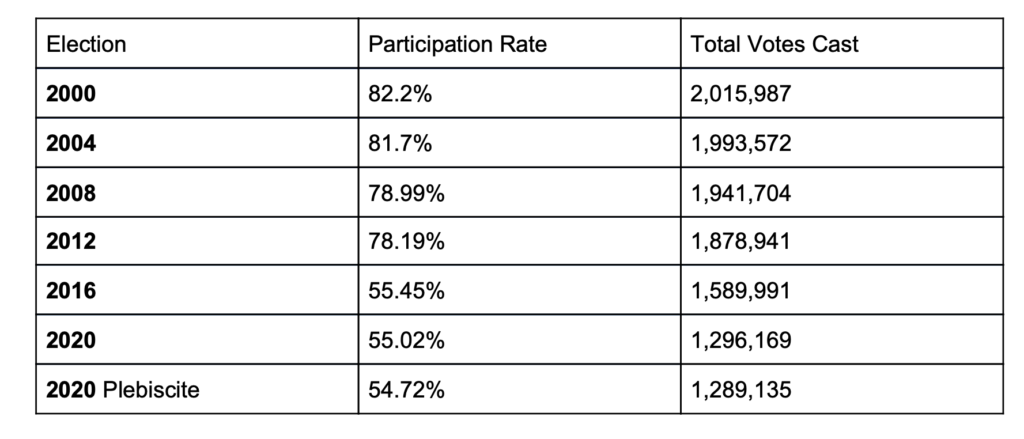Puerto Rico voted for statehood — again — in 2020. Once again we saw, and every recent poll had shown, that the majority of Puerto Rico voters want statehood. A clear majority voting for statehood is the most democratic act of self-determination you can imagine.
The anti-statehood faction isn’t satisfied. They can’t win the votes, so they try to discredit the votes. This time around, they’re trying to claim that voter turnout is an issue.
Does voter turnout change the results?
In a word: no. There is no requirement for a quorum, no minimum number of required votes, and no rules about turnout in U.S. elections, or in Puerto Rico elections in particular. In 2015, the Mayor of Dallas was elected with just 5% turnout.
It doesn’t matter. The decision is up to the people who show up.
Was turnout low?
Actually, it wasn’t. As the chart below shows, the total number of votes in the plebiscite was comparable to the total number of votes case in the 2020 general election as a whole. The participation rate was higher than in 2016.
The total number of votes in 2016 was higher than in 2020. However, Puerto Rico’s population is lower. In 2020, according to Worldometer, Puerto Rico’s population was estimated at 2,860,863. In 2016, the estimate was 3,283,125. With 422,262 fewer residents, it is natural that there should be several hundred thousand fewer votes.
Additional factors
Before 2016, voters in Puerto Rico were removed from the rolls of registered voters if they missed just one general election. In 2016, the US Court of Appeals for the 1st Circuit held that Puerto Rico’s election law violated the federal Help America Vote Act (HAVA. The law was changed to deactivate voters only if they missed two general elections in a row.
This decision caused the reactivation of around 800,000 purged voters. They were reinstated as “active voters” for the 2016 election, inflating voter rolls significantly.
The chart above shows this change if you compare 2016 and after with 2012 and before. While the number of votes cast decreases every year as the population falls, the apparent participation rate falls much faster. The registered voters count is not accurate.
It also cannot be overlooked that Puerto Rico has been strictly locked down during the pandemic, and has also faed many COVID-19 cases and deaths. A survey of Puerto Ricans in the states found a high level of concern about voting during the pandemic. We do not extrapolate from this survey to voters in Puerto Rico, but we think it is reasonable to expect that some voters chose not to vote for this reason.
Why is this an issue?
The anti-statehood factions were able to use the “low turnout” claim to discredit the 2017 vote, or at least to confuse Congress enough to delay action. They’re trying to repeat those results. Let’s not let them confuse the issue this time.
A majority of voters chose statehood. Statehood won. Now is the time for action, not for further debate. Tell your representatives so. If you have friends and family in the states, ask them to do the same.








No responses yet